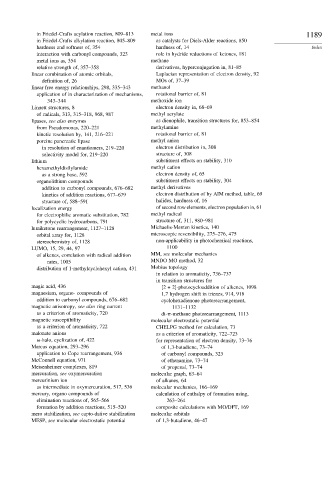Page 1202 - Advanced Organic Chemistry Part A - Structure and Mechanisms, 5th ed (2007) - Carey _ Sundberg
P. 1202
in Friedel-Crafts acylation reaction, 809–813 metal ions 1189
in Friedel-Crafts alkylation reaction, 805–809 as catalysts for Diels-Alder reactions, 850
hardness and softness of, 354 hardness of, 14 Index
interaction with carbonyl compounds, 323 role in hydride reductions of ketones, 181
metal ions as, 354 methane
relative strength of, 357–358 derivatives, hyperconjugation in, 81–85
linear combination of atomic orbitals, Laplacian representation of electron density, 92
definition of, 26 MOs of, 37–39
linear free energy relationships, 298, 335–343 methanol
application of in characterization of mechanisms, rotational barrier of, 81
343–344 methoxide ion
Linnett structures, 8 electron density in, 68–69
of radicals, 313, 315–318, 968, 987 methyl acrylate
lipases, see also enzymes as dienophile, transition structures for, 853–854
from Pseudomonas, 220–221 methylamine
kinetic resolution by, 141, 216–221 rotational barrier of, 81
porcine pancreatic lipase methyl anion
in resolution of enantiomers, 219–220 electron distribution in, 308
selectivity model for, 219–220 structure of, 308
lithium substituent effects on stability, 310
hexamethyldisilylamide methyl cation
as a strong base, 592 electron density of, 65
organolithium compounds substituent effects on stability, 304
addition to carbonyl compounds, 676–682 methyl derivatives
kinetics of addition reactions, 677–679 electron distribution of by AIM method, table, 69
structure of, 588–591 halides, hardness of, 16
localization energy of second row elements, electron population in, 61
for electrophilic aromatic substitution, 782 methyl radical
for polycyclic hydrocarbons, 791 structure of, 311, 980–981
lumiketone rearrangement, 1127–1128 Michaelis-Menten kinetics, 140
orbital array for, 1128 microscopic reversibility, 275–276, 475
stereochemistry of, 1128 non-applicability in photochemical reactions,
LUMO, 15, 29, 44, 97 1100
of alkenes, correlation with radical addition MM, see molecular mechanics
rates, 1005 MNDO MO method, 32
distribution of 1-methylcyclohexyl cation, 431 Mobius topology
in relation to aromaticity, 736–737
in transition structures for
magic acid, 436 [2 + 2]-photocycloaddition of alkenes, 1098
magnesium, organo- compounds of 1,7 hydrogen shift in trienes, 914, 918
addition to carbonyl compounds, 676–682 cyclohexadienone photorearrangement,
magnetic anisotropy, see also ring current 1131–1132
as a criterion of aromaticity, 720 di- -methane photorearrangement, 1113
magnetic susceptibility molecular electrostatic potential
as a criterion of aromaticity, 722 CHELPG method for calculation, 73
malonate anions as a criterion of aromaticity, 722–723
-halo, cyclization of, 422 for representation of electron density, 73–76
Marcus equation, 293–296 of 1,3-butadiene, 73–74
application to Cope rearrangement, 936 of carbonyl compounds, 323
McConnell equation, 971 of ethenamine, 73–74
Meisenheimer complexes, 819 of propenal, 73–74
mercuration, see oxymercuration molecular graph, 63–64
mercurinium ion of alkanes, 64
as intermediate in oxymercuration, 517, 536 molecular mechanics, 166–169
mercury, organo compounds of calculation of enthalpy of formation using,
elimination reactions of, 565–566 263–264
formation by addition reactions, 515–520 composite calculations with MO/DFT, 169
mero stabilization, see capto-dative stabilization molecular orbitals
MESP, see molecular electrostatic potential of 1,3-butadiene, 46–47

